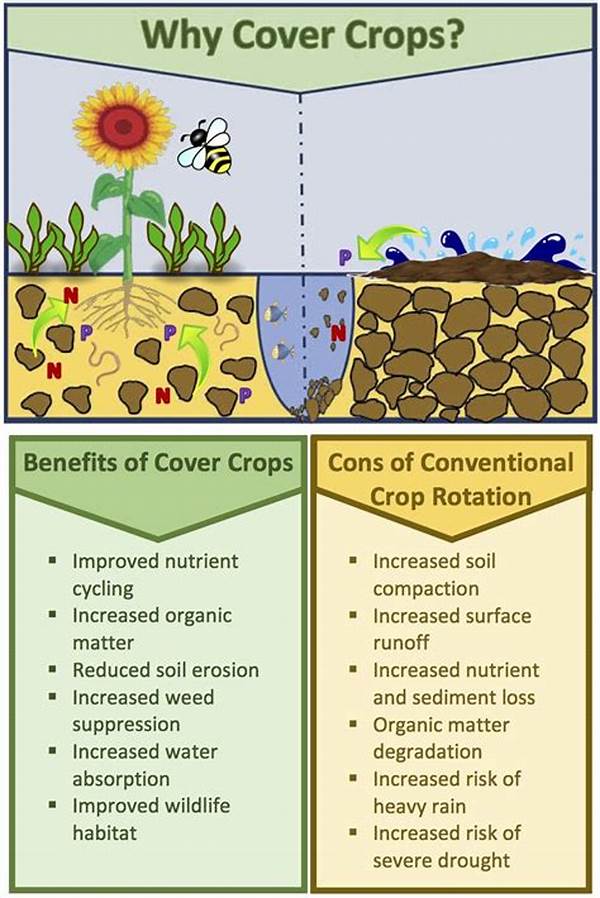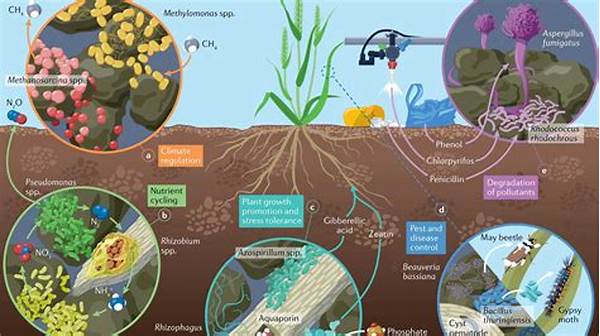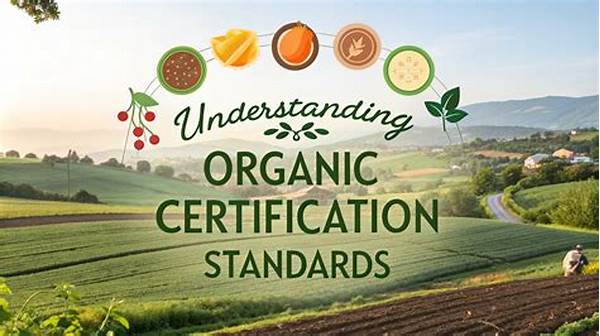In the pursuit of sustainable agriculture and long-term soil health, cover crops present an undeniable advantage. They serve as the unsung heroes of farming, working tirelessly beneath the surface to rejuvenate and enrich the soil. By integrating cover crops into your farming practices, you unlock a world of possibilities for soil improvement, enabling your land to breathe, thrive, and prosper like never before. The compelling benefits of cover crops are not just limited to soil health; they extend to the entire ecosystem, promoting a balance that has lasting impacts on agricultural productivity and environmental sustainability.
Read Now : Sustainable Agriculture Through Biodiversity
Enhancing Soil Health through Cover Crops
Embracing cover crops as a tool for soil improvement is more than a smart choice—it’s a transformative one. These remarkable plants act as nature’s own remedy for boosting soil fertility and preventing erosion. Cover crops, with their extensive root systems, anchor the soil, reducing the risk of erosion and nutrient runoff. The result is richer, more fertile soil that can sustain crops year after year. Additionally, cover crops improve soil structure by enhancing its aeration and water retention capabilities. This improvement in soil quality is not just beneficial—it is essential for increasing agricultural productivity. By choosing cover crops, farmers invest in the future resilience of their fields, reaping the cover crop benefits for soil improvement that ensure healthier harvests and more sustainable farming practices.
Moreover, cover crops are instrumental in managing soil organic matter and increasing biodiversity within the soil. As these crops decompose, they add organic matter back into the earth, creating a nutrient-rich environment that fosters beneficial micro-organisms. This microbial activity is the backbone of nutrient cycling, transforming previously unavailable nutrients into elemental forms that crops can easily absorb. In this way, cover crops rejuvenate the soil’s vitality, paving the way for enhanced crop yields and robust plant health.
Integrating cover crops into a farming system is a commitment to nurturing the soil—a commitment that pays dividends in enhanced crop performance and ecological benefits. These plants serve as natural pest controllers, breaking pest and disease cycles and reducing the need for chemical inputs. This environmentally friendly approach not only boosts the land’s fertility but also upholds the integrity of nearby ecosystems. The choice to utilize cover crops is a pledge towards a sustainable future where cover crop benefits for soil improvement stand as a testament to responsible farming.
The Multifaceted Advantages of Cover Crops
1. Erosion Control: Cover crops form a protective blanket over the soil, significantly reducing erosion by wind and rain. This cover crop benefit for soil improvement ensures that nutrients remain where they are needed most.
2. Soil Structure Enhancement: With their deep-reaching roots, cover crops naturally aerate the soil, improving its structure and water retention capacity—key aspects of cover crop benefits for soil improvement.
3. Weed Suppression: Cover crops act as natural weed suppressors, preventing sunlight from reaching weed seeds and thus inhibiting their growth, making weed management more sustainable and effective.
4. Nutrient Cycling: Cover crops trap excess nutrients from previous crops, preventing leaching and improving the nutrient profile of the soil. This boosts soil fertility through the unique cover crop benefits for soil improvement.
5. Biodiversity Boost: By introducing a variety of cover crops, farmers can enhance biodiversity, supporting a wider range of organisms that contribute to a balanced and healthy ecosystem.
Strategies for Successful Cover Crop Implementation
Implementing cover crops successfully requires a strategic approach that aligns with agricultural goals and environmental conditions. To capitalize on cover crop benefits for soil improvement, farmers must choose species that are well-suited to their specific climate and soil type. This involves understanding the growing cycle of cover crops, ensuring that they do not compete with primary crops for resources. Timing is key—planting cover crops during the shoulder seasons maximizes their growth potential and soil-enhancing benefits without disrupting the main growing cycles.
Furthermore, a diverse mixture of cover crops can maximize soil improvement benefits by catering to different functions, such as nitrogen fixation using legumes or deep soil penetration with taproot species. This diversity not only enriches the soil but also broadens the range of organic matter decomposition processes. Farmers should rotate these cover crops to break pest and disease cycles, a vital aspect of maintaining a healthy soil ecosystem.
When managed effectively, cover crops can transform ordinary farmland into verdant fields of biodiversity and productivity. The ability to adapt cover crop strategies to changing environmental conditions ensures long-term sustainability and resilience against climate change. As awareness about sustainable agriculture grows, more farmers are recognizing the value of cover crop benefits for soil improvement, driving a worldwide movement towards healthier and more sustainable farming landscapes.
Selecting the Right Cover Crops for Optimal Soil Enhancement
Choosing the right cover crops is a nuanced process that involves understanding the specific needs of the soil and the farming goals at hand. Farmers must consider their soil’s unique conditions—such as pH levels, organic matter content, and previous crop history—to select cover crops that will maximize the benefits of soil improvement. For instance, legumes like clover and peas are excellent for fixing nitrogen, while grasses like rye and barley are unparalleled for erosion control and adding biomass.
Integrating a diverse array of cover crops can further enhance soil quality by promoting a balanced ecosystem and preventing pest infestations. Mixtures of different plant species contribute to a variety of root structures and organic matter profiles, leading to improved soil texture and fertility. The practical benefits of selecting the right cover crops do not end with soil health; they extend to reducing costs related to fertilizers and pesticides, making sustainability both achievable and economically viable.
The journey to harnessing cover crop benefits for soil improvement is one of informed decision-making and strategic planning. By carefully selecting species that align with the specific requirements of their land, farmers set the stage for a more sustainable and productive agricultural future. This proactive approach not only revitalizes the soil but also supports higher yields and healthier crops season after season, underscoring the transformative power of cover crops in modern agriculture.
The Economic and Environmental Impact of Cover Crops
Cover crops aren’t just a boon for the soil; they also bring significant economic and environmental advantages. By enhancing soil health, they reduce the need for chemical fertilizers and pesticides, leading to lower input costs for farmers. This reduction in dependency on agrochemicals is not just economically beneficial—it is a major stride toward more environmentally friendly farming practices. The decreased chemical runoff helps preserve waterways and protects local wildlife, showcasing cover crop benefits for soil improvement as an ecologically responsible choice.
Moreover, the increased biodiversity and improved soil structure resulting from cover crops contribute to higher resilience against extreme weather conditions. This resilience means less crop loss and damage, translating to more consistent yields and stable income for farmers. The long-term economic benefits of integrating cover crops outweigh the initial investment, proving that these natural soil enhancers are a wise choice for forward-thinking farmers.
Read Now : Non-chemical Pest Management Approaches
By supporting sustainable agriculture, cover crops facilitate a harmony between farming and the environment, demonstrating that economic viability and environmental stewardship can go hand in hand. As the agricultural industry continues to seek innovative methods for sustainable growth, cover crop benefits for soil improvement stand out as a testament to nature’s ability to bolster both productivity and ecological balance. Farmers, consumers, and the planet all stand to gain from the widespread adoption of cover crops.
Steps to Maximize Cover Crop Benefits
1. Select Appropriate Species: Choose cover crops based on your specific soil needs and climate. Optimal selection enhances cover crop benefits for soil improvement, addressing unique agricultural challenges.
2. Diversify Cover Crops: Utilize a mix of species to enhance soil biodiversity and resilience. This diversification supports a healthy soil ecosystem.
3. Optimize Planting Times: Plant cover crops during shoulder seasons to maximize growth without competing with primary crops.
4. Monitor Growth Cycles: Regularly check cover crop development to ensure they effectively fulfill their soil improvement roles.
5. Implement Crop Rotation: Rotate cover crops to break pest cycles and enhance soil health through natural processes.
6. Incorporate Cover Residue: Allow cover crops to decompose, enriching the soil with organic matter and improving its nutrient profile.
7. Evaluate Soil Health: Regular soil testing can help optimize cover crop strategies, maximizing their benefits and adjusting practices as needed.
8. Adjust Management Practices: Flexibility is key; be willing to alter management techniques to suit changing environmental conditions.
9. Educate and Collaborate: Engage with agricultural experts to stay informed about effective cover crop practices and innovations.
10. Commit to Sustainable Practices: Employ long-term strategies for using cover crops to uphold soil health and agricultural productivity, ensuring benefits for future generations.
Embracing the Future of Soil Health
Cover crops represent an agricultural renaissance, promising a brighter future for both soil health and sustainable farming practices. By acknowledging and harnessing the potential of cover crop benefits for soil improvement, farmers pave the way for a future where soil vitality and agricultural productivity go hand in hand. These unassuming plants hold the key to unlocking healthier soils, enhanced crop yields, and a more balanced ecosystem. As we stand at the crossroads of modern agriculture, embracing the transformative power of cover crops offers an inspiring vision for the future—one where every farmer becomes a steward of the land, dedicated to nurturing and preserving our planet’s invaluable resources.
The potential for positive change through cover crops is immense and continues to gain momentum as more farmers adopt this sustainable strategy. By investing in practices that prioritize long-term soil health, the agricultural community takes significant strides toward food security and environmental conservation. The choice to implement cover crops is a testament to forward-thinking agriculture and an enduring commitment to making our planet a healthier, more resilient place for future generations.
In conclusion, cover crops serve as a powerful ally in the quest for soil improvement and sustainable agriculture. The myriad benefits they bring—ranging from enhanced soil structure to reduced chemical usage and increased biodiversity—demonstrate their indispensability in modern farming practices. By embracing cover crop benefits for soil improvement, farmers can ensure not only immediate gains but also a sustainable agricultural legacy.



